B-17 Bomber
 When the airmen went off to war, their hope was that their plane would be able to stand up to the attacks that would be coming their way. In World War II, big war planes were very new. The men who spent the war in them, needed a plane that would take a hit and keep on flying. They would love to have a flying suit of armor, but it also had to be able to fly. A plane that was too heavy, obviously wouldn’t fly, and yet, they needed a plane that could get hit with shrapnel or bullets and still stay in the air. They knew that they couldn’t make sure that every plane that was hit would make it home, but they needed as many as possible to do just that.
When the airmen went off to war, their hope was that their plane would be able to stand up to the attacks that would be coming their way. In World War II, big war planes were very new. The men who spent the war in them, needed a plane that would take a hit and keep on flying. They would love to have a flying suit of armor, but it also had to be able to fly. A plane that was too heavy, obviously wouldn’t fly, and yet, they needed a plane that could get hit with shrapnel or bullets and still stay in the air. They knew that they couldn’t make sure that every plane that was hit would make it home, but they needed as many as possible to do just that.
There were a number of planes that were considered almost indestructible, or at least as indestructible as it is possible to be for an airplane in a war zone. Two of them…the Boeing B-17 Flying Fortress, a four-engined heavy bomber developed in the 1930s for the United States Army Air Corps (USAAC), and the Boeing B-29 Superfortress, a US 4-engine propeller bomber, manufactured from 1943 to 1946 and used throughout the Korean War, as well as World War II. The name “Fortress” was coined when B-17, with its heavy firepower and multiple machine gun emplacements, made its public debut in July 1935. A reporter for The Seattle Times, Richard Williams, exclaimed, “Why, it’s a flying fortress!” The Boeing Company saw the value of that name and immediately had it trademarked. The truth of the matter is, however, that the planes had the ability to take a hit and still bring their boys home most of the time, provided the damage wasn’t too heavy.
These heavy bombers are bomber aircraft capable of delivering the largest payload of bombs, as well as the longest range, which is takeoff to landing distance, of their era. For those reasons, the heavy bombers are 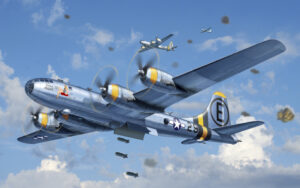 usually among the largest and most powerful military aircraft at any point in time. Nevertheless, as the 20th century wound down, the heavy bombers were largely superseded by strategic bombers. The strategic bombers were often smaller in size, which allowed for much longer ranges and by necessity, these were capable of delivering nuclear bombs. It was a sign of the times, but for all World War II buffs, like me, it was a sad end of an era. The newer planes are great, don’t get me wrong, but they just don’t have the presence, at least in my mind, that the World War II heavy bombers did. Those old planes had a grace that the newer stuff simply doesn’t have. I suppose that my love of the B-17, at least, stems from the fact that it was the plane that brought my dad home safely…so he could become my dad.
usually among the largest and most powerful military aircraft at any point in time. Nevertheless, as the 20th century wound down, the heavy bombers were largely superseded by strategic bombers. The strategic bombers were often smaller in size, which allowed for much longer ranges and by necessity, these were capable of delivering nuclear bombs. It was a sign of the times, but for all World War II buffs, like me, it was a sad end of an era. The newer planes are great, don’t get me wrong, but they just don’t have the presence, at least in my mind, that the World War II heavy bombers did. Those old planes had a grace that the newer stuff simply doesn’t have. I suppose that my love of the B-17, at least, stems from the fact that it was the plane that brought my dad home safely…so he could become my dad.
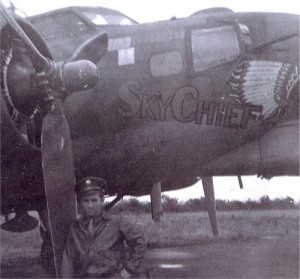
 For most World War II history buffs, like me, there is only one bomber worth taking about…the B-17 Bomber. I’m sure there have been many bombers since, but the B-17 will always stand out in my mind. I’m sure that is partly because my dad spent his entire time in World War II as the Top Turret Gunner and Flight Engineer on a B-17G Bomber, stationed at Great Ashfield in Suffolk, England, about nine miles from Bury Saint Edmonds.
For most World War II history buffs, like me, there is only one bomber worth taking about…the B-17 Bomber. I’m sure there have been many bombers since, but the B-17 will always stand out in my mind. I’m sure that is partly because my dad spent his entire time in World War II as the Top Turret Gunner and Flight Engineer on a B-17G Bomber, stationed at Great Ashfield in Suffolk, England, about nine miles from Bury Saint Edmonds.
Dad was so proud of the beautiful, brand-new B-17G Bomber. The thing he might have known, but that I certainly didn’t, is that when those shiny brand-new B-17 Bombers came out and were sent out to battle, they were already considered to be outdated. Of course, outdated, does not mean they couldn’t be used, because they not only could be used, but they were very effective. I suppose that the fact that they were outdated could have meant that they were slower, more awkward, or less accurate, but during World War II, they were very effective, and the people they protected were extremely grateful for their prominent presence on the 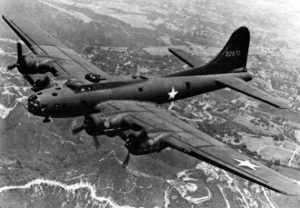
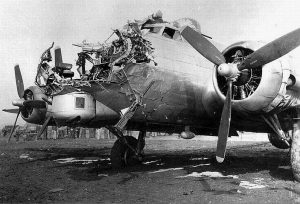 battlefield. Those planes were almost indestructible…short of losing a wing anyway.
battlefield. Those planes were almost indestructible…short of losing a wing anyway.
While the reality is that far more Consolidated B-24 Liberators were produced and were used more extensively than B-17s, both as bombers and in other roles. Nevertheless, the B-17 had a following. It was beloved by so many people…even though it was predominantly used in the Eighth Air Force. Really, it is most likely because the historians, who were mainly focusing on the war in Europe, and who have devoted so much coverage to the Boeing B-17 Flying Fortress, that the B-17 is often thought of as the only American bomber of the war, or at least until the much larger B-29 Superfortress was introduced by Boeing. Still, the B-29 Superfortress, in the minds of many people anyway, couldn’t hold a candle to the B-17 if the minds of the people. In fact, while thousands of Douglas A-20s, North American B-25s, and Martin B-26s, as well as excellent British bombers 
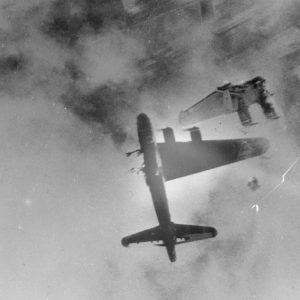 such as the Lancaster and Wellington, served in all theaters of war, it was The Fort, as it has lovingly been called, that has come to symbolize the air war perhaps more than any other bomber…of any era. For me, the B-17 will always be the most awesome, and greatest bomber ever built. When one flies overhead, I recognize the sound. I can pick one out while it is flying, even if it is too far away to hear the engines. If I had to pick an airplane that will always be iconic, the B-17 is it, and always will be.
such as the Lancaster and Wellington, served in all theaters of war, it was The Fort, as it has lovingly been called, that has come to symbolize the air war perhaps more than any other bomber…of any era. For me, the B-17 will always be the most awesome, and greatest bomber ever built. When one flies overhead, I recognize the sound. I can pick one out while it is flying, even if it is too far away to hear the engines. If I had to pick an airplane that will always be iconic, the B-17 is it, and always will be.
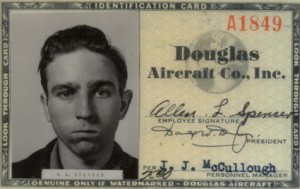 My dad, Allen Spencer, went to work for Douglas Aircraft Company on May 19, 1942. He was a young man of just 18 years. Dad wasn’t with Douglas Aircraft Company for very long, because of World War II, and his enlistment in the Army Air Force on March 12, 1943. Nevertheless, the job my dad had while he was at Douglas Aircraft Company would play a big part in his future military assignment as a flight engineer on a B-17 Bomber during World War II, stationed at RAF Great Ashfield in Suffolk, England. Because of Dad’s job there, I have always had an interest in Douglas Aircraft Company.
My dad, Allen Spencer, went to work for Douglas Aircraft Company on May 19, 1942. He was a young man of just 18 years. Dad wasn’t with Douglas Aircraft Company for very long, because of World War II, and his enlistment in the Army Air Force on March 12, 1943. Nevertheless, the job my dad had while he was at Douglas Aircraft Company would play a big part in his future military assignment as a flight engineer on a B-17 Bomber during World War II, stationed at RAF Great Ashfield in Suffolk, England. Because of Dad’s job there, I have always had an interest in Douglas Aircraft Company.
While people might think they don’t know much about Douglas Aircraft Company, they really do, just under a different name. The Douglas Aircraft Company was an American aerospace manufacturer based in Southern California. It was founded in 1921 by Donald Wills Douglas Sr and later merged with McDonnell Aircraft in 1967 to form McDonnell Douglas. With that merger, Douglas Aircraft Company ceased to exist. The name McDonnell Douglas might be a bit more familiar to people, but it was really when McDonnell Douglas merged with Boeing in 1997 that the company became a household name. Everyone has heard of Boeing Aircraft Company.
While Douglas Aircraft Company no longer exists, they made great strides in the aerospace industry during their time in business. One early claim to fame was the first circumnavigation of the world by air in Douglas airplanes in 1924. That was just 21 years after the first powered flight, taken by the Wright Brothers. That may sound like a long time, but to go from the rickety-looking plane the Wright Brothers flew, to something that was  capable of making the flight around the world in just 21 years is truly outstanding. The circumnavigation mission was first presented to Douglas Aircraft Company in 1923, when the US Army Air Service, interested in carrying out a mission to circumnavigate the Earth for the first time by aircraft, approached Douglas Aircraft Company to present it to them. The mission was called “World Flight.” Donald Douglas proposed a modified Douglas DT to meet the Army’s needs. The two-place, open cockpit DT biplane torpedo bomber had previously been produced for the US Navy. The DTs were taken from the assembly lines at the company’s manufacturing plants in Rock Island, Illinois, and Dayton, Ohio, to be modified.
capable of making the flight around the world in just 21 years is truly outstanding. The circumnavigation mission was first presented to Douglas Aircraft Company in 1923, when the US Army Air Service, interested in carrying out a mission to circumnavigate the Earth for the first time by aircraft, approached Douglas Aircraft Company to present it to them. The mission was called “World Flight.” Donald Douglas proposed a modified Douglas DT to meet the Army’s needs. The two-place, open cockpit DT biplane torpedo bomber had previously been produced for the US Navy. The DTs were taken from the assembly lines at the company’s manufacturing plants in Rock Island, Illinois, and Dayton, Ohio, to be modified.
Four of these modified aircraft left Seattle, Washington, on April 6, 1924, flying west, and two of these returned there on September 28 to great fanfare. Unfortunately, one plane had been lost under fog conditions, and another was forced down over the Atlantic and sank. The DWC prototype was then rechristened and joined the other two in completing the North American leg of the flight. With the success of this flight, the Army Air Service ordered six similar aircraft as observation aircraft.
In 1934, Douglas produced a commercial twin-engined transport plane, the Douglas DC-2, which was followed by the famous DC-3 in 1936. The wide range of aircraft produced by Douglas included airliners, light and medium bombers, fighter aircraft, transports, reconnaissance aircraft, and experimental aircraft. While these were all important types of aircraft, it would really be the work they did during World War II, that really put 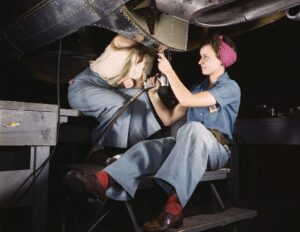 them on the map in my opinion. With so many young men heading off to war, the women really stepped up at this time and built many of the World War II planes. During that time, Douglas joined the BVD (Boeing-Vega-Douglas) consortium to produce the B-17 Flying Fortress. As far as I’m concerned, that was one of the greatest planes every produced. I suppose that sounds odd, considering that it was so long ago, but for its time, the B-17 was and really still is legendary. And while I don’t know if my dad had a part in building the B-17 Bomber, I know that he repaired them and knew them inside and out. I am proud of the work my dad did on the airplanes he helped to build, and proud of his time with Douglas Aircraft Company.
them on the map in my opinion. With so many young men heading off to war, the women really stepped up at this time and built many of the World War II planes. During that time, Douglas joined the BVD (Boeing-Vega-Douglas) consortium to produce the B-17 Flying Fortress. As far as I’m concerned, that was one of the greatest planes every produced. I suppose that sounds odd, considering that it was so long ago, but for its time, the B-17 was and really still is legendary. And while I don’t know if my dad had a part in building the B-17 Bomber, I know that he repaired them and knew them inside and out. I am proud of the work my dad did on the airplanes he helped to build, and proud of his time with Douglas Aircraft Company.

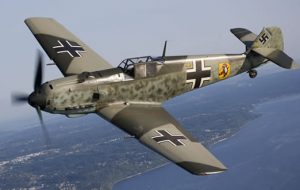 When the B-17 was built, it was designed to be a formidable weapon against the enemy, namely the Nazis and the Japanese. Early on, before long-range fighter escorts came into being, B-17s had only their .50 caliber M2, the B-17s were on their own out there. Still, the B-17 was not defenseless. With those .50 caliber M2s, the crew had the ability to fire at the enemy from every direction…almost. The job of the Messerschmitt fighters was to take down the B-17s. The Messerschmitt fighter planes were designed to break world air speed records. They were also the hope of the Germans to take down the B-17s. Still, there were all those guns to deal with. Luftwaffe fighter pilots agreed that attacking a B-17 combat box formation to encountering a fliegendes Stachelschwein, “flying porcupine,” with dozens of machine guns in a combat box aimed at them from almost every direction. The biggest downfall of the B-17 bombing formation was that they had to fly straight, making them vulnerable to German flak. It was the first line of defense the Germans had when the bombers came in.
When the B-17 was built, it was designed to be a formidable weapon against the enemy, namely the Nazis and the Japanese. Early on, before long-range fighter escorts came into being, B-17s had only their .50 caliber M2, the B-17s were on their own out there. Still, the B-17 was not defenseless. With those .50 caliber M2s, the crew had the ability to fire at the enemy from every direction…almost. The job of the Messerschmitt fighters was to take down the B-17s. The Messerschmitt fighter planes were designed to break world air speed records. They were also the hope of the Germans to take down the B-17s. Still, there were all those guns to deal with. Luftwaffe fighter pilots agreed that attacking a B-17 combat box formation to encountering a fliegendes Stachelschwein, “flying porcupine,” with dozens of machine guns in a combat box aimed at them from almost every direction. The biggest downfall of the B-17 bombing formation was that they had to fly straight, making them vulnerable to German flak. It was the first line of defense the Germans had when the bombers came in.
In a 1943 survey, the USAAF found that over half the bombers shot down by the Germans had left the protection of the main formation. The Germans needed a training plan. The United States developed the bomb-group formation, which evolved into the staggered combat box formation in which all the B-17s could safely cover any others in their formation with their machine guns, making a formation of bombers a dangerous target to engage by enemy fighters. The Messerschmitt fighters were fast, but they could not just fly at the formation. They would be shot down for sure. So, they looked for the bomber that had been hit and had to pull out of formation. Then they would move in for the kill. Moreover, German fighter aircraft later developed the tactic of high-speed strafing passes rather than engaging with individual aircraft to inflict damage with minimum risk. It was a way of not fully engaging the “flying porcupine.” As a result, the B-17s’ loss rate was up to 25% on some early missions. They needed something more to provide a kind of shield against the enemy.
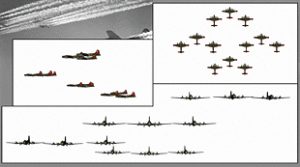
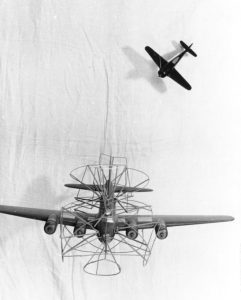
It was not until the advent of long-range fighter escorts (particularly the North American P-51 Mustang) and the resulting degradation of the Luftwaffe as an effective interceptor force between February and June 1944, that the B-17 became strategically potent. They needed the P-15 Mustang to keep the Messerschmitts off of them. So in the end, the German training didn’t do them much good against the “flying porcupine.”

 High up in the Big Horn Mountains, about 23 miles from Buffalo, Wyoming, rest the remains of a B-17F-55-DL Flying Fortress, serial number 42-3399, nicknamed “Scharazad.” The highest peak in the Big Horn Range is Cloud Peak, at an elevation of 12,840 feet. After the crash of the bomber, the next peak over, the one on which the bomber rests was renamed Bomber Mountain. The plane is still there today, but the bodies of the crew, William R Ronaghan (pilot), Anthony J Tilotta (co-pilot), Leonard H Phillips (navigator), Charles H Suppes (bombardier), James A Hinds (aircraft engineer), Ferguson T Bell Jr (radio operator), Lee ‘Vaughn’ Miller (assistant aircraft engineer), Charles E Newburn Jr (assistant radio operator), Jake F Penick (aircraft gunner), Lewis M Shepard (assistant aircraft gunner), were recovered from the crash site and given a proper burial.
High up in the Big Horn Mountains, about 23 miles from Buffalo, Wyoming, rest the remains of a B-17F-55-DL Flying Fortress, serial number 42-3399, nicknamed “Scharazad.” The highest peak in the Big Horn Range is Cloud Peak, at an elevation of 12,840 feet. After the crash of the bomber, the next peak over, the one on which the bomber rests was renamed Bomber Mountain. The plane is still there today, but the bodies of the crew, William R Ronaghan (pilot), Anthony J Tilotta (co-pilot), Leonard H Phillips (navigator), Charles H Suppes (bombardier), James A Hinds (aircraft engineer), Ferguson T Bell Jr (radio operator), Lee ‘Vaughn’ Miller (assistant aircraft engineer), Charles E Newburn Jr (assistant radio operator), Jake F Penick (aircraft gunner), Lewis M Shepard (assistant aircraft gunner), were recovered from the crash site and given a proper burial.
On June 28, 1943, the B-17F “Scharazad” left Pendleton, Oregon to join a bomber group headed to Europe during World War II. Around midnight, Captain Ronaghan radioed that their position was near Powder River, Wyoming. That was the last transmission, and they were never heard from again. The Army launched multiple search campaigns to find the missing plane among the mountains, but modern search aids like GPS were not available until the 1960s, and planes can be difficult to find in mountainous terrain anyway, due to trees and grasses blending with the green tones of the plane.
It would take two long years for the families of these fallen men to have closure, and it came by chance, really. On August 12, 1945, two cowboys spotted the shiny aluminum from the wreckage and discovered all ten crew members deceased. For two years the paint color had allowed the plane to be hidden on the mountain, but as 
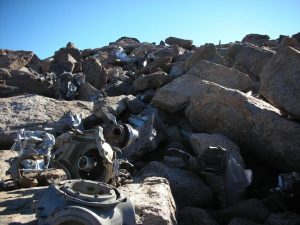 time, and the elements, went on, the paint wore off, and the shining aluminum allowed the plane to be located. The mountain was named “Bomber Mountain” in their memory. I can’t imagine the pain of loss the families of the crew must have felt knowing that their loved one had died, but to have no real idea what happened for two long years…must have been very hard to bear. Knowing where it all happened, while not removing the pain, at least brings peace.
time, and the elements, went on, the paint wore off, and the shining aluminum allowed the plane to be located. The mountain was named “Bomber Mountain” in their memory. I can’t imagine the pain of loss the families of the crew must have felt knowing that their loved one had died, but to have no real idea what happened for two long years…must have been very hard to bear. Knowing where it all happened, while not removing the pain, at least brings peace.
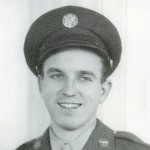
 As I have researched the infantry soldiers of World War II, my thought was that I was really thankful that my dad, Allen Spencer was not one of those men on the ground during the fighting. I felt bad for those men who were on the ground, fighting from the foxholes. I still do, because they were in constant danger. Bombs fall from the sky, and bullets fly from across the battlefield. If those things didn’t kill a soldier, the freezing cold, trench foot, or dysentery from the horribly unsanitary conditions could. It seemed that my dad’s situation was by far safer, but now, I’m not so sure that’s true.
As I have researched the infantry soldiers of World War II, my thought was that I was really thankful that my dad, Allen Spencer was not one of those men on the ground during the fighting. I felt bad for those men who were on the ground, fighting from the foxholes. I still do, because they were in constant danger. Bombs fall from the sky, and bullets fly from across the battlefield. If those things didn’t kill a soldier, the freezing cold, trench foot, or dysentery from the horribly unsanitary conditions could. It seemed that my dad’s situation was by far safer, but now, I’m not so sure that’s true.
The book I had been listening to, that took in World War II from D-Day to The Battle of the Bulge, talked mostly about the ground war, but then at the end, the reader said something that really struck me. It was about the look that crossed the face of a bomber crew’s faces before certain missions…those that would inevitably find the plane flying through flak. The look was one of fear. I knew flak was dangerous, but somehow I didn’t really connect flak with bringing down a plane, or seriously injuring its occupants. Nevertheless, it is quite dangerous for them.
As I researched the dangers of flak, a shocking revelation made itself known. I had written a story about the life expectancy of the ball turret gunner. My findings were that that life expectancy was about 12 seconds. That may be true when one is talking about the prospect of being shot, but when it comes to flak, that cannot be said. Apparently, where flak is concerned, the best place to be is in the plexiglass structure of the ball turret. Plexiglass holds up better against flak than other areas of the plane, so the ball turret gunner is much more protected…at least from flak. The same cannot be said for the bullets flying through the area. I was thankful that my dad was not a ball turret gunner, and that he only filled in as a waist gunner periodically. The waist gunners were in the open, where protection from bullets, and from flak was minimal…at best, non-existent at worst. I can’t imagine how those memories must have affected my dad, but in the book I listened to, the main reason many of the men didn’t want to talk about their experiences in World War II, or any war, was because talking about it brought those memories flooding in again.
After researching flak, and how it works, I can see why the men would get a look of fear on their faces as they prepared to go through areas anti-aircraft weapons shooting flak into the air. Some men said that they could see the red hot glow in the center of the flak, if it was very close. That tells me that it was like a small explosive devise. No wonder it could bring so much damage to a plane. I had known that flak could put holes in the fuselage, but somehow I hadn’t tied that with bringing down a plane. I surmise that it was the B-17 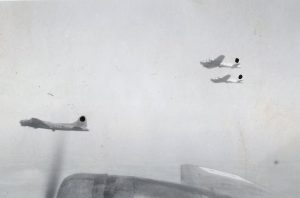
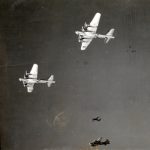 bomber top turret gunner’s daughter in me that wouldn’t allow me to place that danger around my dad. I didn’t want to think about the dangers of his every mission in World War II. My mind seems to have placed his plane in a bubble or a force field, so that no danger could come near him. I think every veteran wonders why they were spared, when others didn’t make it back home. I don’t think anyone can answer that question. As a Christian, I have to credit God for bringing my future dad home.
bomber top turret gunner’s daughter in me that wouldn’t allow me to place that danger around my dad. I didn’t want to think about the dangers of his every mission in World War II. My mind seems to have placed his plane in a bubble or a force field, so that no danger could come near him. I think every veteran wonders why they were spared, when others didn’t make it back home. I don’t think anyone can answer that question. As a Christian, I have to credit God for bringing my future dad home.

 A while back, my sister, Cheryl Masterson and I were talking about our Dad, Allen Spencer’s military training. Like much of Dad’s military service, big discussions about his training days were non-existent. So, I decided to trace his military career, to the best ability I could, and basically take a walk in his footsteps. We knew that he shipped out of Fort Snelling, Minnesota, and then spent time in Salt Lake City, Utah and in Kearney, Nebraska. We weren’t sure exactly where his basic training took place or his training for the B-17. That conversation got my curiosity going, and I decided that I needed to check it out. It’s not always easy to research a persons path through every aspect of their lives, but with the knowledge that he initially started out at Fort Snelling, I hoped to trace the rest of his journey through World War II. Fort Snelling, it turns out was a Reception Center. The men and women started there, received their vaccinations, medical exams, and their gear. They were classified and assigned to a unit. Then they were shipped out for their basic training.
A while back, my sister, Cheryl Masterson and I were talking about our Dad, Allen Spencer’s military training. Like much of Dad’s military service, big discussions about his training days were non-existent. So, I decided to trace his military career, to the best ability I could, and basically take a walk in his footsteps. We knew that he shipped out of Fort Snelling, Minnesota, and then spent time in Salt Lake City, Utah and in Kearney, Nebraska. We weren’t sure exactly where his basic training took place or his training for the B-17. That conversation got my curiosity going, and I decided that I needed to check it out. It’s not always easy to research a persons path through every aspect of their lives, but with the knowledge that he initially started out at Fort Snelling, I hoped to trace the rest of his journey through World War II. Fort Snelling, it turns out was a Reception Center. The men and women started there, received their vaccinations, medical exams, and their gear. They were classified and assigned to a unit. Then they were shipped out for their basic training.
Most of the men in dad’s original unit would go on to become part of the transport or supply teams, but because my dad had a job building airplanes for Douglas Aircraft Company prior to enlisting in the Army Air Force, he was moved to a unit that would spend the war in a B-17G flying Fortress Bomber. For my dad, it was an epic job. He often wrote home to his family about just how amazing the B-17 Bomber was, and how proud 
 he was to be serving on one. Part of dad’s job was to be the flight engineer, another position that stemmed from his vast knowledge of airplanes. The flight engineer knew the all equipment on the B-17 better than the pilot and any other crew member from the engines to the radio equipment to the armament to the engines to the electrical system and to anything else. Many flight engineers served as maintenance crew chiefs before moving to the position of a B-17 flight engineer. The flight engineer was also the top turret gunner. Dad’s training for his work took him to Miami Beach, Florida, then to Gulfport, Mississippi, and Dyersburg, Tennessee.
he was to be serving on one. Part of dad’s job was to be the flight engineer, another position that stemmed from his vast knowledge of airplanes. The flight engineer knew the all equipment on the B-17 better than the pilot and any other crew member from the engines to the radio equipment to the armament to the engines to the electrical system and to anything else. Many flight engineers served as maintenance crew chiefs before moving to the position of a B-17 flight engineer. The flight engineer was also the top turret gunner. Dad’s training for his work took him to Miami Beach, Florida, then to Gulfport, Mississippi, and Dyersburg, Tennessee.
In Gulfport, Mississippi, dad was trained as a flight airplane mechanic, and it was here that he volunteered to become an aerial gunner as well. He received his wings in November 1943, following gunnery training in Las Vegas, Nevada. Dyersburg Army Air Force Base was the largest combat aircrew training school built during the early war years. It was the only inland B-17 Flying Fortress training base east of the Mississippi River. The base was located on 2,541 acres, not including the practice range. Approximately 7,700 crew men received their last phase training at DAAB. From Dyersburg AAB, dad was sent to Kearney, Nebraska. There he and his crew were assigned a brand new B-17G bomber. Shortly thereafter they flew to New York to be dispatched to their base in the European Theater…Great Ashfield, Suffolk, England. Before arriving there, he wasn’t even sure where he was going, because these things were kept top secret, and were revealed on a need-to-know basis. Based out of Great Ashfield, dad flew 36 missions, one more that the required 35, having volunteered to fill in for a sick 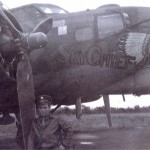
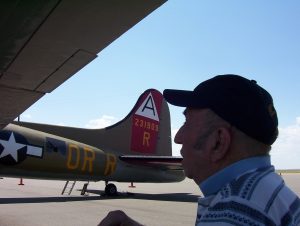 crewmember on the final flight. In one of his letters, he told his family not to worry about him, because as he said, “I’m not afraid of what the near future might bring. I’m going into combat fully confident of my plane, crew, and myself. And I know that with the help of God, I’ll come home again in just as good a condition as I am right now.” And so he did. Today would have been my dad’s 95th birthday. Happy birthday in Heaven Dad. We love and miss you very much and we are so proud of you.
crewmember on the final flight. In one of his letters, he told his family not to worry about him, because as he said, “I’m not afraid of what the near future might bring. I’m going into combat fully confident of my plane, crew, and myself. And I know that with the help of God, I’ll come home again in just as good a condition as I am right now.” And so he did. Today would have been my dad’s 95th birthday. Happy birthday in Heaven Dad. We love and miss you very much and we are so proud of you.
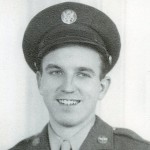 In 1990, when the remake of the movie, Memphis Belle came out, I watched it with intrigue, knowing that my Dad, Allen Spencer had been a top turret gunner and flight engineer on a B-17G Bomber in the 8th Air Force stationed in Great Ashfield, Suffolk, England. The Memphis Belle, a Boeing-built B-17F-10-BO, USAAC Serial No. 41-24485, was added to the USAAF inventory on July 15, 1942, and delivered in September 1942 to the 91st Bombardment Group at Dow Field, Bangor, Maine. She deployed to Prestwick, Scotland, on September 30, 1942, moving to a temporary base at RAF Kimbolton on October 1, 1942, and then finally to her permanent base at Bassingbourn, England, on October 14, 1942. Each side of the fuselage bore the unit identification markings of the 324th Bomb Squadron (Heavy). My dad was a part of the 385th Bomb Squadron (Heavy). Dad didn’t arrive in England until early April of 1944. His letter from April 14, 1944 tells his family that he had arrived and couldn’t tell them where he was for security reasons, except to say that he was somewhere in England.
In 1990, when the remake of the movie, Memphis Belle came out, I watched it with intrigue, knowing that my Dad, Allen Spencer had been a top turret gunner and flight engineer on a B-17G Bomber in the 8th Air Force stationed in Great Ashfield, Suffolk, England. The Memphis Belle, a Boeing-built B-17F-10-BO, USAAC Serial No. 41-24485, was added to the USAAF inventory on July 15, 1942, and delivered in September 1942 to the 91st Bombardment Group at Dow Field, Bangor, Maine. She deployed to Prestwick, Scotland, on September 30, 1942, moving to a temporary base at RAF Kimbolton on October 1, 1942, and then finally to her permanent base at Bassingbourn, England, on October 14, 1942. Each side of the fuselage bore the unit identification markings of the 324th Bomb Squadron (Heavy). My dad was a part of the 385th Bomb Squadron (Heavy). Dad didn’t arrive in England until early April of 1944. His letter from April 14, 1944 tells his family that he had arrived and couldn’t tell them where he was for security reasons, except to say that he was somewhere in England.
At the time I watched the remake of the original 1943 documentary film put out by the War Department, I assumed that while the movie said it was based on a true story, there was probably a lot of Hollywood hype to 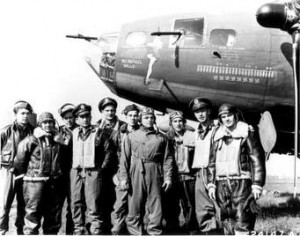 the movie. So, when I read my dad’s letter to his mother, my grandmother, Anna Schumacher Spencer, I was surprised that my dad mentioned it and said she should go see it. From my experience with the movie, I don’t think it would be a film I’d want to watch while my child was still on active duty and fighting from one of those planes. Both the original version and the remake were real enough to either show or tell of events involving the B-17 Bombers in combat situations, and the inevitable shooting down of the planes by the enemy.
the movie. So, when I read my dad’s letter to his mother, my grandmother, Anna Schumacher Spencer, I was surprised that my dad mentioned it and said she should go see it. From my experience with the movie, I don’t think it would be a film I’d want to watch while my child was still on active duty and fighting from one of those planes. Both the original version and the remake were real enough to either show or tell of events involving the B-17 Bombers in combat situations, and the inevitable shooting down of the planes by the enemy.
Of course, the point was to let people know that The Memphis Belle, a B-17 Bomber had become the first plane to accomplish 25 missions without being shot down. It was designed to be a celebration of that accomplishment. And so it was, but it also proved the stark reality that many other B-17 Bombers had been shot down, and in all reality would continue to be shot down. While the accomplishment of The Memphis Belle is nothing to take lightly, I think it would still be hard to think about all those men lost or imprisoned during that war…especially if I was the mother of an airman. In some ways, it surprised me that my dad would even ask his mom to so see the movie. He was always so protective of her. I suppose that in time, you get used to the events of war, especially when you are in the thick of it day after day, and maybe he thought it would give her hope too.
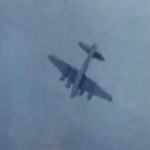
Nevertheless, it seemed rather strange to me that Dad had talked of this movie with his mother. I know that the Memphis Belle was a star, just because they had made it through without being shot down. They were the first, and to those at home trying to support the war effort, that was a moral booster. That made it important to do the movie and to have the Memphis Belle and her crew do tours back in the states. People needed to see the success of the air war. They needed hope that their loved ones would return. I suppose that was what my dad was thinking when he told his mother that she should go see the movie. I don’t know for sure if she did or didn’t, but in the end my dad came home, and that is all that mattered to my grandmother and to me.
 As I continue to read through my dad’s letters to his family during World War II, I have been reading between the lines, and behind the scenes that he was able to share. During a war, the soldiers involved are unable to speak about the operations they are taking part in. Still as young men and women, far away from home, they want and need to write and receive letters. They need the closeness of family, and yet they don’t want to worry their family, and they are bound by military rules, not to talk about the missions. So much so, that letters must be read to make sure no information accidentally gets out.
As I continue to read through my dad’s letters to his family during World War II, I have been reading between the lines, and behind the scenes that he was able to share. During a war, the soldiers involved are unable to speak about the operations they are taking part in. Still as young men and women, far away from home, they want and need to write and receive letters. They need the closeness of family, and yet they don’t want to worry their family, and they are bound by military rules, not to talk about the missions. So much so, that letters must be read to make sure no information accidentally gets out.
Knowing my dad in his later years, and getting to know him through his letters home, I know that he was not a man who wanted others, especially his family to worry about him. So, he never told of pain or fears. Which leads me to believe that my dad wouldn’t have told his family, and especially his mom, what he was feeling during the bombing missions he went on every day. Not even if he could have. That was just the man my dad was…as a young soldier, and as a adult husband and father.
Still, in reading his letters, the need for comfort and reassurance that existed in him every day, whispered quietly from between the lines and behind the words my dad wrote in his letters. He asked for good news concerning men he knew that were in the service too. Hoping that if they were ok, he would be too. Of course, I can’t be sure that those were my dad’s feelings or his thoughts, but I know that is how I felt when I looked at the pictures he took of flak from the German Fliegerabwehrkanone. This was an 88mm gun capable of rapid fire. The resulting shell fragments would rip through the planes and it is said that it took over 3,300 rounds to take down a plane. And those guns did take down planes. The B-17 bombers had to fly through these traps on the way to and from their targets. How could these boys go through that every day and not have fear that they would not come home. I know it took great faith in God to move beyond that fear…to keep going…to survive the  day to day nerve racking missions.
day to day nerve racking missions.
I have great respect for all of our soldiers, because they push their fears back every day, and hide their true feelings from their loved ones so they don’t worry. And yet, when I look at the pictures Dad took of the flak all around their plane, and read the letters telling his family that he is “ok and feeling fine”, which is really a way of saying he is still ok, and not telling them much of anything I think I understand what true bravery is. That was typically my dad, never allowing his feelings to worry his family. I feel that I know my dad better from his letters and it makes me appreciate what a wonderful man he was even more. I love you Daddy!!
 I have been reading some of my dad’s letters that were written to his family while he was in the Army Air Force during World War II. They were written from places as familiar to me as Salt Lake City and as unfamiliar as Great Ashfield, Suffolk, England. He told of all the new experiences he was having, such as flying in the B-17 Bomber, and just checking out the area where he was stationed. And he told of attending church services quite often…something that didn’t change throughout his entire life, and for that I’m thankful. That one thing brings me so much peace of mind…knowing that I will see my dad again.
I have been reading some of my dad’s letters that were written to his family while he was in the Army Air Force during World War II. They were written from places as familiar to me as Salt Lake City and as unfamiliar as Great Ashfield, Suffolk, England. He told of all the new experiences he was having, such as flying in the B-17 Bomber, and just checking out the area where he was stationed. And he told of attending church services quite often…something that didn’t change throughout his entire life, and for that I’m thankful. That one thing brings me so much peace of mind…knowing that I will see my dad again.
But, as I read his letters, there was some sadness in his tone. The life he knew was changing every day, and he was too far away, and powerless to stop it. He was always concerned about his mother and sister living so far out of town on the farm, and even asked his brother to rent them a house in town so life would be easier on them, but then when it seemed that they would not be going back to the farm, it was hard to think of coming home to an unfamiliar house. Then, his brother was thinking about getting married (which he didn’t do at that time or to that girl), and moving to Mexico to work for a time, and it looks like he would not be there for his only brother’s wedding. Suddenly it occurs to my dad that so often, life changes when you least expect it, and you find yourself not ready for those changes. I suppose this is a common feeling with military personnel, in that they have little say about where they are stationed, how long they are there, and when they might get leave.
Life changes are hard anyway, and I suppose that being thousands of miles from home would make them seem so much more unbelievable and unsettling. For me, knowing that my mom still lives in the home I grew up in gives a strong sense of stability, but knowing that my dad is no longer here, is very unsettling. In his letters, dad wondered about men he knew from back home, and asked about their whereabouts often. He was praying for their safety, as I am sure they were for his. I have wondered about those men too. So far, in my reading, he has received no answers about those men, so I wonder if he ever heard news of them. I may never find out.
I don’t like change much myself…at least not the kind that brings with it the sadness of loss. Whether it is loss of childhood days, or loss of life, all loss is painful. I know that the service our military men do for their country and its citizens is necessary, and those who serve are honorable men who deserve our deepest thanks, but I have to mourn with them the loss of parts of their lives that must be sacrificed so others can have the freedoms we so enjoy.
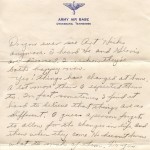 As for my dad, I know that the life he returned to after the war was vastly different than the one he left behind, and I feel a deep sorrow for him in that he must have felt that loss deeply. Dad never talked much about the war, and in fact any information we got had to be pried out of him. Maybe some memories are too painful to relive, and are best left alone. Still, Dad’s letters have shown me a side of my dad that I didn’t exactly know existed…or maybe I did. Dad was always a very caring man, who was extremely loyal to his family…be it his mother, dad, sisters and brother, or my mom, my sisters and me. I suppose that all of life’s changes mold us into the people we are, and so they must be.
As for my dad, I know that the life he returned to after the war was vastly different than the one he left behind, and I feel a deep sorrow for him in that he must have felt that loss deeply. Dad never talked much about the war, and in fact any information we got had to be pried out of him. Maybe some memories are too painful to relive, and are best left alone. Still, Dad’s letters have shown me a side of my dad that I didn’t exactly know existed…or maybe I did. Dad was always a very caring man, who was extremely loyal to his family…be it his mother, dad, sisters and brother, or my mom, my sisters and me. I suppose that all of life’s changes mold us into the people we are, and so they must be.

